|

by
Tony Bushby
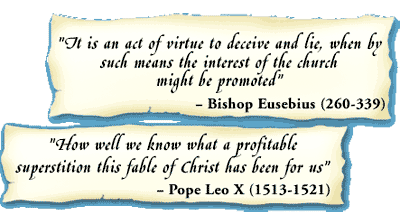
What was the church trying
to hide? IN 1415,THE CHURCH OF ROME TOOK AN EXTRAORDINARY STEP TO
destroy all knowledge of two Second Century Jewish books
that it said contained ‘the true name of Jesus Christ.’
The Antipope Benedict XIII
firstly singled out for condemnation a secret Latin treatise called ‘Mar
Yesu’ and then issued instructions to destroy all copies of the
Book of Elxai. No editions of these writings now
publicly exist, but church archives recorded that they were once in
popular circulation and known to the early presbyters.
Knowledge of
these writings survived from quotations made by Bishop Hippolytus
of Rome (176 –236) and
St Epiphanius of Salamis (315 – 403) along with references in
some early editions of the Talmud of Palestine and Babylonia.
The Rabbinic fraternity once held the destroyed manuscripts with
great reverence for they were comprehensive original records
reporting the ‘Life of Rabbi Jesus’.
|
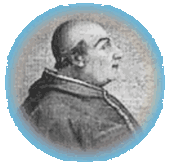
Pope Alexander VI |
Later, in a similar
manner,
Pope Alexander VI (1492 –1503) ordered all copies of the
Talmud destroyed. The Council of the Inquisition required as
many Jewish writings as possible to burn with the Spanish Grand
Inquisitor, Tomas de Torquemada (1420 –98), responsible for
the elimination of 6000 volumes at Salamanca.
In 1550,Cardinal
Caraffa, the Inquisitor-General procured a Bull from the Pope
repealing all previous permission for priests to read the
Talmud which he said contained ‘hostile stories about
Jesus Christ ’. Bursting forth with fury at the head of his
minions, he seized every copy he could find in Rome and burnt them.
Solomon Romano (1554) also burnt many thousands of Hebrew
scrolls and in 1559 every Hebrew book in the city of Prague was
confiscated.
The mass destruction of Jewish books included hundreds of copies of
the Old Testament and caused the irretrievable loss of
many original hand-written documents. The oldest text of the Old
Testament that survived, before the discovery of the Dead
Sea Scrolls was said to be the Bodleian Codex
(Oxford), which was dated to circa 1100AD. In an attempt by the
church to remove damaging Rabbinic information about Jesus Christ
from the face of the earth, the Inquisition burnt 12,000 volumes of
the Talmud. However, many copies survived and today
provide opposing traditions about the person called Jesus Christ.
In the mass destruction of Jewish writings, the church overlooked two
particular British documents that also recorded ‘the true name of
Jesus Christ ’. They survive to this day in the British
Museum and are called the Chronicles and the Myvyean Manuscript treasured ancient documents
with a very early origin.
Supporting evidence was also found on
early First Century gold, silver and bronze coins discovered at the
site of an ancient mint at Camulodunum (Colchester) in
Britain. "Thus the testimony of the Briton coins establishes clearly
and positively the historicity of the traditional ancient
‘Chronicles ’ as authentic historical records."
The evidence is compelling, and additional supporting clues are found
on a mysterious headstone in Germany, in Vatican
art treasures, and in a series of coded sentences in the
Shakespearean Plays. Further concealed information was left
in the form of specially created statues
commissioned by a Catholic priest and positioned in a small hilltop
church in Southern France. Coded ciphers were also secreted into the
first English-language printings of the Bible and a combination of
all clues provides interlocking information and presents a new
insight into the origin of Christianity.
|
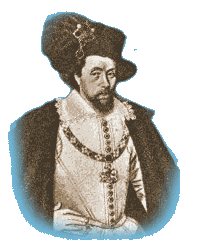
Kink James I |
It was the ‘wisest fool
in Christendom’, King James I, who ‘authorised’ the
translation and publication of the first Protestant version of the
Bible into English. He came to the English throne in 1603 and
quickly became unpopular because of ‘his disgusting personal habits
and his unsavory character’.
He pretended to be a scholar in
theology and philosophy, but his learning was shallow and
superficial. He wallowed in filth, moral and physical, but was
endowed with a share of cunning that his associates called, ‘a
kind of crooked wisdom ’.
For his new edition of the
Bible he issued a set of personal ‘Rules’ the translators were to
follow and ordered revisions to proceed, although he never
contributed a farthing to its cost. Work began early in 1607 and
took a committee of forty-seven men (some records say fifty-four,
others say fifty) two years and nine months to rewrite the Bible and
make ready for the press.
Each man received thirty
shillings per week for his contribution. Upon its completion in
1609,a remarkable event occurred —the translators handed over the
reviser ’s manuscripts of what is now called the King James
Bible to King James for his final personal approval. "It was
self-evident that James was not competent to check their work and
edit it, so he passed the manuscripts on to the greatest genius of
all time ...Sir Francis Bacon".
Sir Francis Bacon (1561 –1626) was a man of many talents, a
lawyer, linguist and composer. He mastered every subject he
undertook; mathematics, geometry, music, poetry, painting,
astronomy, classical drama and poetry, philosophy, history, theology
and architecture. He was a man of many aims and purposes, the father
of modern science, remodeler of modern law, patron of modern
democracy, and possibly the reviver of Freemasonry.
His life and
works are extensively documented, and his intellectual
accomplishments widely recognized, particularly in academic circles.
At the age of sixteen, he was sent to Paris ‘direct from the Queens
Hand ’ and there studied Egyptian, Arabian, Indian and Greek
philosophy with particular attention given to the Ancient Mysteries
and their Ritual Rites.
He personally recorded
that, while in Paris, he created a secret cipher system
that could be inserted into a document without arousing suspicion.
While living in Europe, Francis Bacon was initiated into the
mysterious Order of the Knights Templar
and learnt a very special secret. Before he returned to London, he
traveled to France, Italy, Germany and Spain and at the age of
twenty completely devoted himself to the study of law.
From his
understanding of the secret information he had learned during his
initiation into the Knights Templar, he conceived the idea of
reactivating various Secret Societies and in 1580 founded the secret
Rosicrucian Literary Society in Gray’s Inn. Later in the same year,
he founded the Lodge of Free and Accepted or Speculative Masons,
also at Gray’s Inn.
On 25 June 1607 Sir Francis Bacon was appointed
Solicitor-General and Chief Advisor to the Crown. He had presented
new ideas to the Government for the Reformation of the church and
was officially instructed to commence restructuring the Bible.
Research in the Records Office of the British Museum revealed that
original documents still exist which refer to important proceedings
associated with Sir Francis Bacon’s involvement with the
editing of both the Old and New Testaments They revealed that he
personally selected and paid the revisers of the New Testament who
completed their task
|
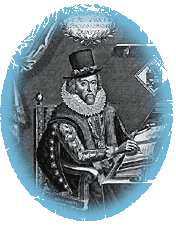
Sir Francis Bacon |
under the instructions of Bacon’s
long-time friend, Dr Andrews.
The first English language
manuscripts of the Bible remained in
Bacon’s possession for nearly a year. During that time:
...he hammered the various
styles of the translators into the unity, rhythm, and music of
Shakespearean prose, wrote the Prefaces and created the whole scheme
of the Authorized Version.
He also encoded
secret information into both the Old and New Testament An
ancient document recorded that the true history of early
Christianity was known to the initiates of the Order of
the Knights Templar, having originally been:
...imparted to Hugh de
Payens by the Grand Pontiff of the Order of the Temple (of
the Nazarene sect), one named Theocletes, after which it
was learned by some Knights in Palestine.
Regarding the months of
editing work applied to the Bible by Bacon, his biographer,
William T.Smedley, confirmed the extent of the editing:
It will eventually be
proved that the whole structure of the Authorized Bible was
Francis Bacon’s. He was an ardent student not only of the Bible,
but also of early manuscripts. St Augustine, St Jerome, and writers
of theological works, were studied by him with industry.
At the completion of the
editing,
Sir Francis Bacon and King James I
had a series of meetings to finalize editorial matters associated with
the new Bible. It was at this time that King James ordered a
‘Dedication to the King ’ to be drawn up and included in the opening
pages. He also wanted the phrase ‘Appointed to be read in the
Churches ’ to appear on the title page. This was an announcement
clarifying that
King James had personally given the church ‘Special Command ’
for this particular version of the Bible to be used in preference to
the vast array of Greek and Latin Vulgate Bibles current at
the time. His reason was personal, as King James had
previously instructed the revisers to ‘defend the position of the
king ’ in their restructuring of the texts.
This was seen as an
attempt to distance the
Protestant Bible
from the Catholic version. The Protestant versions of
the Bible are thinner by seven books than the Catholic version and
the variant churches have never agreed on a uniform Bible. In
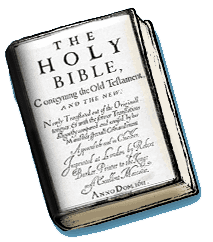 their
translation of
1 Peter 2:13 the revisers changed the phrase ‘the
emperor, as supreme’ to ‘the king, as supreme’. their
translation of
1 Peter 2:13 the revisers changed the phrase ‘the
emperor, as supreme’ to ‘the king, as supreme’.
Because King
James’ Bible was written to support the authority of a king, the
later church often referred to it as the one from ‘authority ’,and
it later came to be presented as if officially ‘authorised ’.In
subsequent revisions, the word ‘authorised ’ found its way onto the
title page and later still came to be printed on the cover, giving
King James’ new Bible a false sense of authenticity.
The King James Bible is
considered by many today to be the ‘original’ Bible and therefore
‘genuine’ and all later revisions simply counterfeits forged by
‘higher critics’. Others think the King James
Bible is ‘authentic’ and ‘authorised’ and presents the original words
of the authors as translated into English from the ‘original’ Greek
text.
However, the ‘original' Greek text was not written until
around the mid-Fourth Century and was a revised
edition of writings compiled decades earlier in Aramaic and Hebrew.
Those earlier documents no longer exist and the Bibles we have today
are five linguistic removes from the first Bibles written. What was
written in the
‘original originals’ is quite unknown. It is important
to remember that the words ‘authorised’ and ‘original’, as applied
to the Bible, do not mean ‘genuine’, ‘authentic’ or ‘true’.
|
More information about
this subject, making "click" on image right |
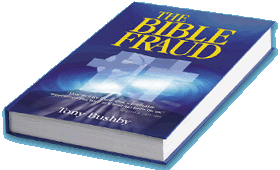 |
|